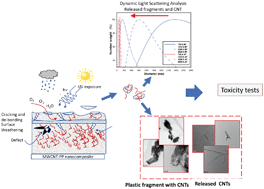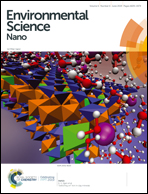Polypropylene–MWCNT composite degradation, and release, detection and toxicity of MWCNTs during accelerated environmental aging†
Abstract
Nanomaterials (NM) are incorporated into polymers to enhance their properties. However, there are a limited number of studies on the aging of these nanocomposites and the resulting potential release of NM. To characterize NM at critical points in their life cycles, polypropylene (PP) and multiwall carbon nanotube filled PP (PP–MWCNT) plates with different thicknesses (from 0.25 mm to 2 mm) underwent accelerated weathering in a chamber that simulates solar irradiation and rainfall. The physicochemical changes of the plates depended on the radiation exposure, the plate thickness, and the presence of MWCNT fillers. Photodegradation increased with aging time, making the exposed surface more hydrophilic, decreasing the surface hardness and creating surface stress-cracks. The aged surface and cross-section showed crazing due to the polymer bond scission and the formation of carbonyls. The degradation was higher near the UV-exposed surface as the intensity of the radiation and oxygen diffusion decreased with increasing depth of the plates, resulting in an oxidation layer directly proportional to oxygen diffusion. Thus, the sample thickness determines the kinetics of the degradation reaction and the transport of reactive species. Plastic fragments, which are less than 1 mm, and free CNTs were released from weathered MWCNT–PP plates. The concentrations of released NM that were estimated using ICP-MS increased with prolonged aging time. Various toxicity tests, including reactive oxygen species generation and cell activity/viability, were performed on the released CNTs. The toxicity of the released fragments and CNTs to A594 adenocarcinomic human alveolar basal epithelial cells was observed. The released polymer fragments and CNTs did not show significant toxicity under the experimental conditions in this study. This study will help manufacturers, users of consumer products with nanocomposites and policymakers in the development of testing guidelines, predictive models, and risk assessments and risk based-formulations of NM exposure.



 Please wait while we load your content...
Please wait while we load your content...